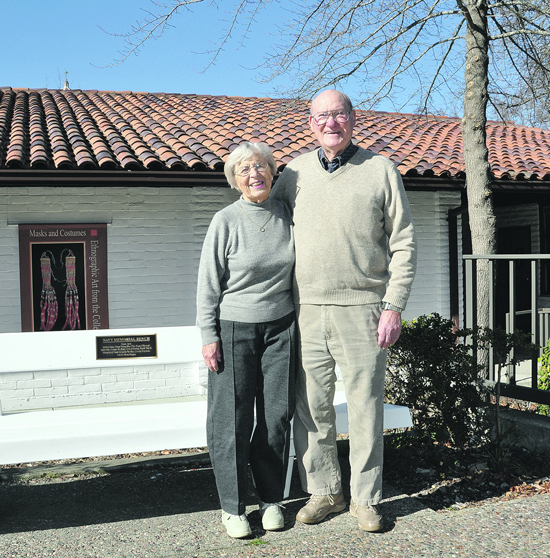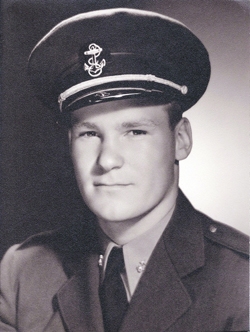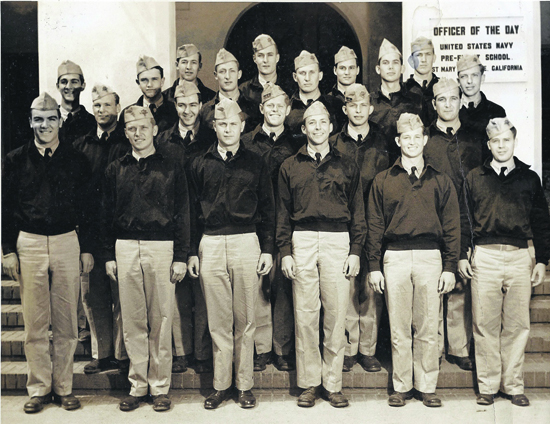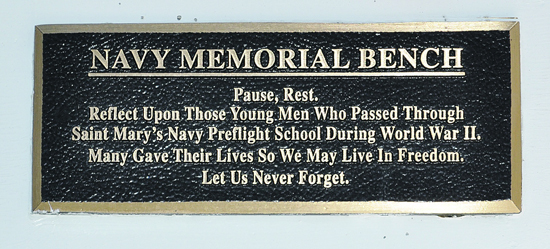 | | | T.B. "Teeb" Thomas and wife Rudi at the St. Mary's College Navy Memorial bench honoring Preflight school cadets.
Photo Andy Scheck
| | | | | |
In a quiet grove behind St. Mary's football field is a statue dedicated to Our Lady of the Oaks. Its inscription reads in part: "in honor of the 1427 [St. Mary's College] men...who answered their country's call...in World War II." Several hundred yards away, alongside the Brother Cornelius Art Center, the "Navy Bench" invites pedestrians to pause and rest: "Reflect upon those young men who passed through St. Mary's Navy Preflight School during World War II." What follows is one man's story.
 T.B. "Teeb" Thomas of Orinda has long loved to fly. But before he got off the ground, he trained as a cadet in the US Naval Preflight School at St. Mary's College.
T.B. "Teeb" Thomas of Orinda has long loved to fly. But before he got off the ground, he trained as a cadet in the US Naval Preflight School at St. Mary's College.
 Thomas was born and raised in South Dakota, and moved to Salinas, California his senior year of high school. He signed up as a V-5 recruit to take the Navy's basic flight training program in January, 1943 and graduated high school at age 17 in February. After a short stint at a Salinas junior college, Thomas was sent to flight prep school in San Luis Obispo. Next stop: St. Mary's College.
Thomas was born and raised in South Dakota, and moved to Salinas, California his senior year of high school. He signed up as a V-5 recruit to take the Navy's basic flight training program in January, 1943 and graduated high school at age 17 in February. After a short stint at a Salinas junior college, Thomas was sent to flight prep school in San Luis Obispo. Next stop: St. Mary's College.
 When Thomas arrived in March 1944, the sleepy campus with its pre-war enrollment of barely 300 was gearing up into a boomtown of 2,000 khaki-clad Navy and Marine personnel. Thomas became a member of the 1st Platoon, 47th Battalion. He said the campus held "a few [religious] brothers, no civilians, and it was all male." Underclassmen bunked in temporary housing, while upperclassmen occupied dorms still in use today. Cadets were confined to the campus during their first six weeks. There were "no cameras, no weddings and no marriages." Staying single didn't bother most cadets, says Thomas; they were still young.
When Thomas arrived in March 1944, the sleepy campus with its pre-war enrollment of barely 300 was gearing up into a boomtown of 2,000 khaki-clad Navy and Marine personnel. Thomas became a member of the 1st Platoon, 47th Battalion. He said the campus held "a few [religious] brothers, no civilians, and it was all male." Underclassmen bunked in temporary housing, while upperclassmen occupied dorms still in use today. Cadets were confined to the campus during their first six weeks. There were "no cameras, no weddings and no marriages." Staying single didn't bother most cadets, says Thomas; they were still young.
 Training and discipline were the program watchwords. The workload combined academics with physical training, or PT. Cadets studied meteorology, astronomy, and math, and played football, baseball, basketball and soccer. They swam, ran track, boxed and wrestled. Military training included practicing water escapes from a mock plane cockpit, recognizing and estimating numbers of friendly and enemy aircraft, and pistol and rifle practice. Thomas recalls that he and his fellow cadets "did a lot of drilling" and studied until 10:00 p.m. Once they hiked from the campus to the top of Mt. Diablo in survival gear carrying a backpack that held "too much."
Training and discipline were the program watchwords. The workload combined academics with physical training, or PT. Cadets studied meteorology, astronomy, and math, and played football, baseball, basketball and soccer. They swam, ran track, boxed and wrestled. Military training included practicing water escapes from a mock plane cockpit, recognizing and estimating numbers of friendly and enemy aircraft, and pistol and rifle practice. Thomas recalls that he and his fellow cadets "did a lot of drilling" and studied until 10:00 p.m. Once they hiked from the campus to the top of Mt. Diablo in survival gear carrying a backpack that held "too much."
 In June of 1944, with the war turning in favor of the Allied forces, officials decided to "wash out" (release) half the V-5 class. Cadets called it "the purge." "Luckily," says Thomas, "I made it." Thomas earned his wings at Corpus Christi, Texas, after advanced flight training in a bi-wing Boeing Stearman 75 and an SBD Dauntless dive bomber. Ensign Thomas was then transferred to the Naval Air Station in Deland, Florida where he met his future wife, who was then a Navy WAVE. Thomas was discharged in December, 1945 and married in Monterey on Valentine's Day, 1946. Thomas attended U.C. Berkeley on the G.I. Bill, and became an industrial engineer. He and wife Rudi settled in Orinda in 1949 because Thomas knew and liked the area from his time at St. Mary's. They put four sons through local schools. Thomas says he owned and flew private planes, including a Piper super cub and a Cessna 172, into his 80's. Although he finally gave up the pilot's seat, he still flies --as a passenger --with his pilot son. He donated his flight suit to the Alameda Naval Air Museum.
In June of 1944, with the war turning in favor of the Allied forces, officials decided to "wash out" (release) half the V-5 class. Cadets called it "the purge." "Luckily," says Thomas, "I made it." Thomas earned his wings at Corpus Christi, Texas, after advanced flight training in a bi-wing Boeing Stearman 75 and an SBD Dauntless dive bomber. Ensign Thomas was then transferred to the Naval Air Station in Deland, Florida where he met his future wife, who was then a Navy WAVE. Thomas was discharged in December, 1945 and married in Monterey on Valentine's Day, 1946. Thomas attended U.C. Berkeley on the G.I. Bill, and became an industrial engineer. He and wife Rudi settled in Orinda in 1949 because Thomas knew and liked the area from his time at St. Mary's. They put four sons through local schools. Thomas says he owned and flew private planes, including a Piper super cub and a Cessna 172, into his 80's. Although he finally gave up the pilot's seat, he still flies --as a passenger --with his pilot son. He donated his flight suit to the Alameda Naval Air Museum.
 Thomas helped organize and attended a 1995 reunion for preflight school cadets, held at St. Mary's College. The cadre of former cadets is aging; many have filed their final flight plan. Those who remain are close to their 90th birthdays. But in spite of that, and the urgency of a nation then at war, Thomas says his St. Mary's College days were "one of the better times in my life."
Thomas helped organize and attended a 1995 reunion for preflight school cadets, held at St. Mary's College. The cadre of former cadets is aging; many have filed their final flight plan. Those who remain are close to their 90th birthdays. But in spite of that, and the urgency of a nation then at war, Thomas says his St. Mary's College days were "one of the better times in my life."
 From Private College to
From Private College to
 Government Venue:
Government Venue:
 St. Mary's Becomes a 1940's Wartime Aviation School
St. Mary's Becomes a 1940's Wartime Aviation School

 The Japanese attack on Pearl Harbor left the U.S. military short of fighter pilots. In response, the Navy set up pre-flight training schools across the country. One of those was at St. Mary's College.
The Japanese attack on Pearl Harbor left the U.S. military short of fighter pilots. In response, the Navy set up pre-flight training schools across the country. One of those was at St. Mary's College.
 The Navy ran its school from 1942 to 1946.
The Navy ran its school from 1942 to 1946.
 A future U.S. President (Gerald Ford) coached football on campus in 1945.
A future U.S. President (Gerald Ford) coached football on campus in 1945.
 1427 men with ties to St. Mary's College served in the military during WW II;
1427 men with ties to St. Mary's College served in the military during WW II;
 21 are known to have died in uniform.
21 are known to have died in uniform.

 On February 27, 1942 a telegram was sent to college President Brother Austin:
On February 27, 1942 a telegram was sent to college President Brother Austin:
 "St. Mary's College has been selected by the Navy Department as one of the four locations [across the U.S.] for pre-flight training. Your patriotic cooperation in this vital program is appreciated." Signed: Frank Knox, Secretary of the Navy
"St. Mary's College has been selected by the Navy Department as one of the four locations [across the U.S.] for pre-flight training. Your patriotic cooperation in this vital program is appreciated." Signed: Frank Knox, Secretary of the Navy

 To house and feed its 2,000 cadets, the Navy:
To house and feed its 2,000 cadets, the Navy:
 - Built temporary barracks, a field house (with an indoor swimming pool) and a rifle range. - Built temporary barracks, a field house (with an indoor swimming pool) and a rifle range.
 - Leveled out the land from the Chapel to St. Mary's Road to make athletic fields, some of which are still in use today. - Leveled out the land from the Chapel to St. Mary's Road to make athletic fields, some of which are still in use today.
 - Required East Bay Municipal Utility District (EBMUD) to construct a water pipeline to the campus: "to provide - Required East Bay Municipal Utility District (EBMUD) to construct a water pipeline to the campus: "to provide
 adequate water supply, both for drinking purposes and for fire protection." (Adm. L.E. Denfield, May 12, 1942). adequate water supply, both for drinking purposes and for fire protection." (Adm. L.E. Denfield, May 12, 1942).

 The hills surrounding St. Mary's Moraga campus made a marvelous natural amphitheater, recalls former Marine Corps pilot Chuck Temple of Florence, Oregon. "The bugler would play taps from the [chapel] tower, once slowly, then he'd 'jazz it up', and it would echo all around the hills!"
The hills surrounding St. Mary's Moraga campus made a marvelous natural amphitheater, recalls former Marine Corps pilot Chuck Temple of Florence, Oregon. "The bugler would play taps from the [chapel] tower, once slowly, then he'd 'jazz it up', and it would echo all around the hills!"
 C. Dausman
C. Dausman

 Sources:
Sources:
 Pipe Dream Fulfilled: How the Navy helped bring water to St. Mary's
Pipe Dream Fulfilled: How the Navy helped bring water to St. Mary's
 John Grennan, author
John Grennan, author

 The History of U.S. Navy Pre-Flight School, St. Mary's California, U.S. Navy, 1946
The History of U.S. Navy Pre-Flight School, St. Mary's California, U.S. Navy, 1946

|



